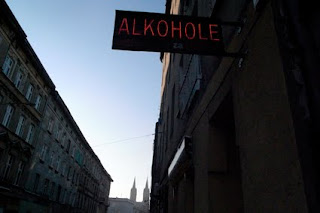For our third exploration of the neigbourhood we wanted to look in the piece South of the church, there where also the Old synagogue Altshtot stood... "nothing remains from this synagoge", so I was curious to see if we could find out where it exactly was located on the Wolborskiej.
Gosia, Agnieszka and I started to walk in that direction to get an idea of the neighbourhood first. Well, it changed during the years as you can see in the pictures. it looks like, and it is actually is, not directly middle-class... but: blocs with apartments, nice houses, well painted, well maintained everything. Families with children, a man who tried to get his car out of the snow, somebody exercising her dog...
This neighbourhood really invites you to live here...
At the border from Baluty you find Park Staromiesky heavy used by the Balutians, winter and summer.
And yes, there we find a sign of the former synagogue... But is this the place where it stood on Wolborskiej? Most probably there where the apartments blocs are now.
This blog starts to go about synagogues only - yes, but... you cannot ignore the former presence from the Polish Jews here in Lodz and certainly not in Baluty... We have to incorporate that - unfortunataly historical - fact in our project without making it the main-issue.
So I promise this will be one of the last times about synagogues.
A little bit further (just behind the sign, you see a glimpse from it totally at the right-hand side of the picture) you find a statue with a text below it which says:
The ten commandments
a sculpter by Gustav Zemla
by page of history
a foundation for
the commemoration of
the presence
of Jews in Poland
november 1995
See in this respect next message: Mur i Wieża































_220110_blg.jpg)














